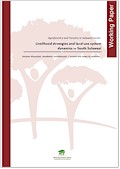| Working Paper Series |
 |
|
| Title | Agroforestry and Forestry in Sulawesi series: Livelihood strategies and land use system dynamics in South Sulawesi | | Author | Noviana Khususiyah, Janudianto, Isnurdiansyah, S. Suyanto and James M Roshetko | | Year | 2012 | | Publisher | World Agroforestry Centre (ICRAF) Southeast Asia Regional Program | | City of Publication | Bogor, Indonesia | | Series Number | Working paper 155 | | Number of Pages | 47 | | Call Number | WP0167-13 | | Keywords | AgFor Sulawesi Project, South Sulawesi, land-use dynamics, livelihoods, income, coffee, cacao, cloves, agroforestry |
|
| Abstract: |
The project ‘Agroforestry and Forestry in Sulawesi: Linking Knowledge with Action’ (the ‘AgFor
Sulawesi Project’) is being implemented in 3 provinces of Sulawesi, Indonesia (South Sulawesi,
Southeast Sulawesi and Gorontalo) from 2011 to 2016 to enhance agroforestry and forestry
livelihood systems of rural communities. The baseline survey reported in this document was
conducted to support the project. The main objectives were to study the general characteristics of
community livelihoods, local farming systems and land-use systems based on community
perspectives. The assessment of land-use dynamics, farming systems and livelihood strategies in 2
districts of South Sulawesi was considered essential for designing the next phase of the project. The
livelihood baseline study addressed both community and household levels.
The group discussion results within the three village typologies showed that there were quite clear
distinctions in terms of livelihood options, tree crops and farm management. In the first typology -
degraded land with annual crops system villages (Kayu Loe and Bonto Karaeng), the maize area had
increased significantly during the last 40 years; conversely there was a significant decrease in
candlenut and other plantation areas. The use of maize induced farmers to manage their land
intensively. In the second typology - agroforestry system villages (Pattaneteang and Campaga),
coffee and clove cultivation had increased quite significantly during the last 40 years but the maize
and forest area had declined. Farmers in these typologies have practised complex agroforestry
systems (coffee, cacao and clove) for a long time. In the third typology - timber-based system villages
(Tugondeng and Tana Towa), land-use dynamics were different. In Tugondeng the coconut area had
increased quite significantly over the last 40 years to the point that it is now the major resource. In
Tana Towa, almost all of the land-use options had remained unchanged during the last 40 years
owing to strong customary law (‘Adat’) in the village to protect forest area from
conversion/encroachment. The agroforestry systems in these villages mirrored those of the second
typology with expanding smallholder timber plantations to support livelihoods.
The household survey concluded that the average total income per year per household for farmers
working in typology 1 was lower than that of typologies 2 and 3. The major sources of income for
farmers in typology 1 were maize fields and remittances; typology 2 farmers depended on their
agroforestry products and typology 3 farmers were supported by coconut plantations and
entrepreneurial activities. The daily per capita income of farmers in typology 1 areas was below the
international poverty line. |
|
|
Download file(s): Click icon to download/open file.
|
| |
File Size |
Description |

|
2,283 KB |
Softcopy |
|
|
|
| Viewed in 2285 times. Downloaded in 693 times. |